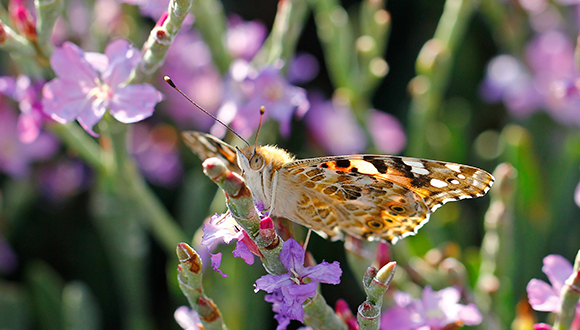The first citizens’ observatory for monitoring urban butterflies is up and running
The observatory is the first of its kind in Spain and CREAF is coordinating the team of scientists behind it. They will be working with volunteers to monitor the evolution of butterfly populations in 54 parks and gardens in Barcelona and Madrid.

As many as 49 different species of butterflies can be found in the parks and gardens of the cities of Madrid and Barcelona, but nobody knows whether their populations are growing or declining, or whether there are more or fewer species now than five years ago. To remedy that situation, CREAF researcher Yolanda Melero, with support from the Spanish government’s Biodiversity Foundation, has set up the urban Butterfly Monitoring Scheme (uBMS), the first citizens’ observatory for monitoring butterflies in Madrid and Barcelona. The observatory will be recruiting at least 40 volunteers in each city to visit specific sites on a fortnightly basis and make a record of the different species and the number of butterflies they see. “This is called species monitoring, in scientific terminology, and it’s a way of finding out about butterfly diversity and population variation over time”, says Melero.
The data obtained will enable the project’s scientists to improve their understanding of urban biodiversity, create an indicator for evaluating biodiversity quality in green areas, and identify the reasons behind certain species appearing or dying out in Madrid and Barcelona.
To ensure the volunteers’ input is useful, a purpose-specific app is to be developed and a workgroup in which they can interact and share their experiences with experts established. Furthermore, they will be offered free training in butterfly identification.
Creating butterfly havens in Madrid and Barcelona
An urban butterfly monitoring scheme is a key step in designing greener, more biodiversity-friendly cities. “Once we have information on the butterfly populations and species at each site and know how they’re evolving, we’ll be able to study how urban development affects them, which plants suit them best, what the ideal size is for a green area, and many other things”, explains Melero. Armed with that knowledge, the team of scientists will be able to advise Madrid City Council and Barcelona City Council, both of which are cooperating with the project, on creating their own havens for butterflies.

“Together, we’ll develop strategies and designs for cities and green areas which will increase butterfly populations and diversity”, says Yolanda Melero.
The observatory is an initiative of CREAF, in conjunction with the Granollers Museum of Natural Sciences, Complutense University of Madrid and the Autonomous University of Madrid. It is supported by similar undertakings, such as Complutense University of Madrid’s Fauna Monitoring Group; CBMS and BMS Spain, the Catalan and Spanish butterfly monitoring schemes; and the European project Butterfly Conservation Europe. As mentioned earlier, it also enjoys the support of the Spanish government’s Biodiversity Foundation and the cooperation of Madrid City Council and Barcelona City Council.
Life in a city for butterflies
City life is not easy for butterflies. Many die when they move to a new site or go in search of a particular type of food that is hard to come by.
Butterfly species that are not strong fliers or only travel short distances are unable to reach distant parks and gardens or those not easily accessible from other green areas.
Many butterflies only feed on specific plants and struggle to find them in gardens, where plants tend to be ornamental. The butterflies that are most common in cities are thus capable fliers with less specific diets, such as whites (Pieris rapae and Pieris brassicae).

Other species that are less common visitors to Spanish cities nonetheless pass through them at certain times of the year when migrating, an example being the painted lady (Vanessa cardui), which can even be seen crossing roads. Species less common to cities, such as the Old World swallowtail (Papilio machaon) and the Iberian marbled white (Melanargia lachesis), are only found in parks and gardens that are close to natural areas or large in size, home to many native plants and rich in biodiversity.







